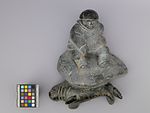Sculpture
About this object
History of use
Contemporary Inuit sculpture produced for the art market began in the 1950's in response to a very successful sale, by the Canadian Handicraft Guild in Montreal in 1949, of pieces collected by James A. Houston on the east coast of Hudson Bay. The Inuit co-operatives developed by 1959 and a central marketing agency was established in 1965. Carving continues to be a major source of income in the Eastern Canadian Arctic, an area which has undergone major social and economic changes, especially since World War II. There has been a steady growth in permanent settlements during the last half of this century which has made large scale carving in stone feasible. Traditionally, carving materials were mainly bone, antler, and ivory, because of their light weight, strength, and durability. Heavier and more fragile stone was used primarily for lamps and cooking vessels. Although Inuit sculpture is often referred to as 'soapstone' sculpture, in fact, less than half of the stone used is soapstone (a high-grade talc or steatite). Other stones commonly used include serpentine, olivine, periodite, chrysolite, and others. In the early years of the industry it was possible to identify where a carving came from by the specific type of stone used, however, in recent years stone is traded on a wider, regional basis. Whale bone, antler, walrus tusk ivory, and a variety of other materials are also used by Inuit carvers. Themes in Inuit sculpture are based on personal experiences and beliefs, derive from oral traditions, mythology, as well as from narrative and figurative themes depicting arctic fauna and scenes of traditional Inuit life. Regional, community, and individual styles are also apparent.
Narrative
Balshine family collection.
Cultural context
contemporary art
Physical description
Hunter is leaning back, almost reclining with his legs braced against a wedge-shaped stone (ice?). There is a walrus lying on its side on the other side of the rock. The hunter is holding a thin hide line which passes through holes in his hands, the top ridge of the rock and attaches to the walrus's body. The walrus's back flippers are crossed and there are four vertical lines along its underbelly and several curved lines at its neck. The hunter has a broad face, rimmed oval eyes and rimmed straight mouth. His hair forms a cap on his head. Large indentation on top side of rock. Hair and walrus have been polished.
